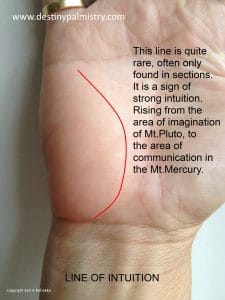| ||||||||||||||
|
Thursday, April 30, 2020
John 6:44-51 | Louis Louro | I am the living bread that came down from heaven
Wednesday, April 29, 2020
Matthew 11:25-30 | Joseph Wright of Derby | You have hidden these things from the wise
| ||||||||||||||
|
"You Can Never Be Lost Where I Cannot Find You"
| ||||||||||||||||
|
Tuesday, April 28, 2020
John 6:30-35 | The Crusader Bible | I am the Bread of Life
| ||||||||||||||
|
Monday, April 27, 2020
Line of Intuition
The shape of the Mercury Line, the Line of Intuition, reveals the nature of a person’s capacity and style for perceiving.
Straight Mercury Lines belong to people who are curious and have keen insights. Curving Mercury Lines, as in Figure 1 below, belong to individuals who are in constant contact, consciously or unconsciously, with the celestial, attuned to messages from the Divine.
Understanding the meaning of life through crisis of meaning
Because this line bows around the Moon mound, you’ll find someone with a natural capacity for diving into crisis of meaning and somehow finding words to make sense of it. On their advanced path, they understand the meaning of life and construct careers as transformational coaches, life purpose consultants, spiritual advisors, life strategists, counselors and ministers.
The owner of a Mercury Line that arcs around the Moon is curious about and considers elements related to dreams, spirituality, the subliminal, unmet emotional needs, and the reality of beliefs. People with Mercury Lines resembling the Figure included in this article have most likely found themselves asking themselves, “What’s the point of living?” and/or “Why are we here?” during times of alienation, stagnation and feeling trapped in the illusion of separation from the self.
While the potential of constant contact with the Divine is very high, equally and opposite is the possibility of not trusting what’s ‘coming in’ and remaining focused entirely on logic instead.
If you have this deeply curving Mercury Line, also known as the Line of Intuition, you most likely understand the feeling of disillusionment and disappointment with life. A sense of despair has led you to ask, “Why?” which is a crucial step toward listening inward for answers. As you stop struggling with the sense of desolation, let go of reason, and accept that you just don’t know why, you find that you surrender to higher intelligence, which then begins to operate through you. You can then allow and trust this special internal mechanism within you that is constantly attuned for deep inner awareness.
Student stories
After teaching about of this type of Mercury Line in my certification program, one student with this configuration confirmed the description saying,
“I worked 14 years in a job where I had little to zero contact with other people. I worked on secret projects and could never talk about my work. I got sick a lot with migraine headaches, felt alone and numbed out. I finally quit that job because I realized life should not be just making money and paying bills. My heart was longing for freedom, freedom for creative expression. I craved deep, meaningful connections with people instead of just working on computers and projects in isolation.”
She has since developed her skills by becoming a Reiki Master /Healer, ThetaHealing® Practitioner, an influential speaker, and intuitive Scientific Hand Analyst and is now working as an inspirational counselor, interpreting the messages marked in the hands to the owners so that they can know why they are here and how to live with meaning in their lives.
After contemplating the interpretation of the Line of Intuition on her hand, another certified hand analyst told me:
“Yes, I do relate to the natural capacity for understanding the meaning in the life crisis -in my own and in other’s, and I have a near compulsion to explain it to a person who’s in the middle of a crisis. I can make sense of things (from an interior perspective), and when a person is asking for my input and is ready to receive it, I can help them make sense of their experiences.
Explaining to someone who isn’t ready to hear it leaves me feeling unseen and misunderstood, and is probably boring or annoying for them. I find that my audience is not always interested, especially not at work so it is a challenge to moderate my natural intuitive communications to fit into the analytical workplace style. I’ve really developed a good practice and the experience to know and trust what’s coming in most of the time, and I can vouch for the experience of constant contact, anytime I put my attention on it, its there.
However, being immersed in the logic of my technology company workplace is like that unsettled, off balance feeling when you don’t trust your own gut. In the office there are lots of interruptions and I’m surrounded by people all the time. It’s a hectic place and instead of listening to and trusting my intuition, I’m usually just reacting to my environment. With the primary focus on logic for the job it’s hard to go deep and open up to listen and receive.”
Interpreting the symbols of the soul
Medical Intuitive Caroline Myss exemplifies what this marking is about as a translator of meaning through her lectures about the invisible energy system running through our bodies called the chakras. In her book Anatomy of the Spirit she interprets the symbols of the soul in easy to understand lessons.
Myss has become very well known through helping people learn the language of the human energy system so that they can better understand themselves as a way through spiritual challenges. Caroline’s life revolves around deciphering meaning in everything around her. In her case she intuits illness as it relates to energetic power leaks within a person. Does she have this line on either of her hands, or both? I don’t know but I’d like to find out.
Intuition is a skill anyone can develop, and would benefit by doing so.
If you don’t have this line in your hand it doesn’t mean that you’re not intuitive or cannot be intuitive. By having this Line of Intuition there is a higher probability, on the path to mastery, that the challenges will be quite evident.
What I mean by this is that reliance on logic and ignoring the hunches you’re getting will block development. This is simply as a road sign indicator letting you know you’re off track and ‘correction’ is needed. Will you trust what you are sensing from within?
Internal oppositions are expected. Recognize and bring the oppositions together as perfect ingredients for fuller expression of highly attuned perceiving.
Mantra: As I follow and trust myself through my own crisis of meaning I am able to skillfully support others through exploration of the deeper parts of themselves.

This article has been edited since it was first posted in Nov. 2016.
https://academyofhandanalysis.org/line-of-intuition/
Intuition Line, Do You Have One?
INTUITION LINE
The Intuition line lies at the side of the hand near the percussion. It rises on Mount of Moon, (lower percussion area) and in a curve, ends on or near the Mount of Mercury (mount beneath the little finger). The distinguishing feature of this line lies in its decided curve. It is a rather uncommon line. I have personally only seen a few in its entirety.
The existence of this line, if well and marked, adds significantly to the intuitive faculties and tends to enhance the Mercurian acuteness. If coupled with long fingers, pointed tips, full Mount of Moon and the head line sloping, the subject will be strongly psychic with visions, and they will be firm advocates in signs and omens. It is also one of the signs of intelligence.
A deeply etched line will give the most considerable amount of intuition. A broken or otherwise defective line (such as islands or crosses on the line) limits its value.

Rising or branching lines from the intuition line
Rising lines from the intuition line to any of the mounts can give clues to the benefits or downfall effects of it.
- A clear line to Mount Jupiter shows potential success from the ambitious use of their powers.
- A line to the Mount of Apollo is a sign of their fame.
- If the line cuts through the line of Saturn (fate/career line), it can mean that use of the intuitive faculties might negatively influence the career. However, if it merges into the line of Saturn, it helps the career.
- If it is partially mixed up with the line of Mercury, the health or nervous system may be affected by its powers if not used wisely.
Don’t mistake the intuition line for the line of Mercury
The line of Mercury, also called a health line, or line of the liver describes a person’s overall state of health. It usually starts on the Mount of Moon and runs upward towards the Mount of Mercury. It can sometimes look like the intuition line. However, this line mainly in indicates the state of the liver and digestive system. However, because of the qualities of Mercury, it can also depict business success or failure. If the line runs deep onto the Mount of Mercury with rising branches, it shows great success in business.
When this line is not present on the hand, it is that the individual is quite robust and rarely suffers health issues. The best kind of line is a clear, sharp line because it implies someone with a good constitution. If at any time the line appears red, inflamed or otherwise discoloured, it can mean there are toxins or an infection present, and the body is trying to fight it.
https://destinypalmistry.com/do-you-have-an-intuition-line/
John 6:22-29 | Vincent Van Gogh | Work for food that endures to eternal life
| ||||||||||||||
|
The Sincere Search for Christ
| |||||||||||||||
|
Sunday, April 26, 2020
Luke 24:13-35 | John Piper | Two Disciples on their way to Emmaus
| ||||||||||||||
|
Subscribe to:
Comments (Atom)










